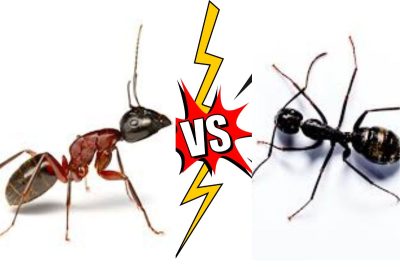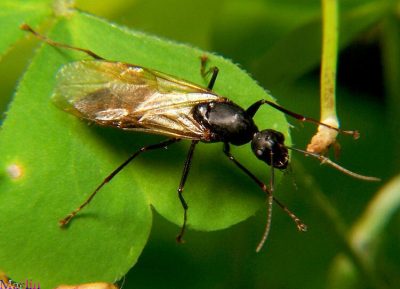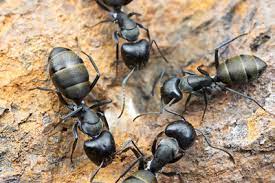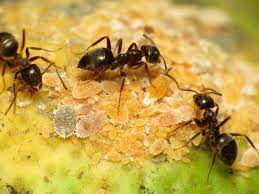Carpenter Ants Vs. Black Ants (11 Ways To Tell Them Apart)
Seeing a black ant inside can cause some panic over whether or not it is a carpenter ant. While black ants do not cause damage, carpenter ants can create severe issues with a home’s structural integrity.
It is helpful to know the difference between carpenter ants and black ants so that you know what steps to take for effective pest control. The best way to tell at first if you have a carpenter ant is to look at the overall size and body shape. They can be as big as an inch long, have heart-shaped heads, and a smooth, rounded thorax (middle).
Read on to learn more about correctly identifying carpenter ants vs black ants.
11 Differences Between Carpenter Ants & Black Ants

Check out this table for a quick overview of a carpenter and black ants’ differences.
Characteristics | Carpenter Ants | Black Ants |
|---|---|---|
| Taxonomy: Genus & Species |
|
|
| Color |
|
|
| Size |
|
|
| Anatomy |
|
|
| Heads & Antennae |
|
|
| Wings |
|
|
| Delivery Method Of Toxins |
|
|
| Habitat & Nesting |
|
|
| Behavior |
|
|
| Damage Caused Inside |
|
|
| Lifespan |
|
|
1. Taxonomy
Carpenter ants belong to the taxonomic genus of Camponotus, consisting of over 1,000 species globally. Black ants belong to the genus Lasius and consist of 149 species.
Due to their color, black carpenter ants, Camponotus pennsylvanicus, are easily confused with black garden ants, Lasius niger.
2. Color
Carpenter ants are typically red, orange, yellow, black, red, black, or brown.

Black ants are a shiny black color or a very dark brown.

3. Size
Ants are impressive creatures that can lift up to 50 times their body weight.
Carpenter ants are larger, with worker ants about ½ – inch (12.7 mm) long and queens up to 1-inch (25.4 mm) long.
Common black ants tend to be smaller in size. Workers are about 0.12 inches (3 mm) long, and the queen is up to 0.35 inches long (9 mm).
4. Anatomy
All insects, including ants, have three main body parts: head, thorax (middle), and abdomen (end), covered with a hard exoskeleton made of chitin. There are slender stalk-like structures called petioles that connect the abdomen and thorax.
Carpenter ants have one segmented petiole with a smooth and rounded thorax.
Black ants have an unevenly-shaped, rigged thorax with 1 or 2 petioles.
5. Heads & Antennae
Ants have powerful odor receptors and antennae for navigating their world.
Carpenter ants have heart-shaped heads with large jaws, and their antennae are elbowed or bent in appearance with only one node.
Black ants have rounded heads with two well-defined antennae with three nodes.
6. Wings
Worker and queen carpenter ants are wingless. However, the swarmers have a set of 2 wings, with the back ones shorter than the front, and swarmer ants leave colonies to start their own.

Some black ant species have wings, whereas others don’t. If they do possess wings, it is typically only 1 set.

7. Delivery Method Of Toxins
Some black ants have stingers on their thoraces, such as fire ants or harvester ants, to inflict toxic venom.
However, carpenter ants do not have stingers and use their large jaws on their heads to deliver an irritant called formic acid.
8. Habitat & Nesting
Carpenter ants are found in many forested parts all over the world. They tend to prefer forest-like features, such as tree stumps. Carpenter ants are most commonly found indoors or outdoors in moist or hollowed wooden areas either indoors or outdoors.
They excavate wood for nesting, which also aids in forest decomposition, leaving behind sawdust due to their excavation.
Carpenter ants typically are found in the walls of structures near wood, moisture, or leaky pipes, whereas black ants will roam around anywhere, especially near food.
Black ants are found in many places, and some habitats are species-specific.
They may nest in trees, wood structures, under piles of debris, or build ant hills in the ground, grasslands, or deserts. Black ants do not typically nest indoors.
Black ants are often found in colonies near food sources and help to aerate the soil, and are prey for animals such as birds and reptiles.
9. Behavior
It is important to note that carpenter ants do not eat wood and have a similar diet to other ants. This includes eating honeydew liquid from aphids, sweets, insects, other arthropods, and even pet food.

However, carpenters and black ants differ in their behavior and activity.
Generally, carpenter ants are active in the spring or fall as they look for wood to nest in, including inside structures, and typically forage at night.
If you think you have found a carpenter ant nest in your home, you can listen carefully through the wall and hear them chewing away.
Black ants are active in the summer months as they gather food during the day and night. If they go inside structures, they search for food to return to their outdoor colony.

10. Damage Caused Inside
While they are not harmful to humans, carpenter ants can extensively and negatively impact the structural integrity of man-made buildings. For example, they hollow out the wood in support beams, wall voids, door frames, etc.
Other issues often invite carpenter ants into a home, including leaky pipes or rotten wood. This ends up as significant repair costs.
Black ants inside your home are just a nuisance. Typically, they seek food sources and can detect sweet or savory scent trails from food debris, pet food, and more.
11. Lifespan
Carpenter ants have a shorter life span but can reproduce quickly, keeping the colony strong. On average, carpenter ants live from 6 to 12 weeks but longer, up to 10 months, in colder climates.
The carpenter ant queen can live up to 25 years, laying thousands of fertilized eggs. It can take 3 to 6 years for carpenter ants to create a thriving colony.
Other ants can vary by species, but black garden ants live longer lives, from 1 to 2 years on average. In addition, queen ants can live incredibly long periods, from 15 to 30 years old.
Conclusion
Black carpenter ants and other black ants can look very much alike to the untrained eye.
However, if you take note of their body shapes, overall size, and area of activity, you can usually figure out which pest you have.
You’ll know it is a carpenter ant if you see an ant that is ½ to 1-inch long, with a heart-shaped head and a rounded thorax. Evidence of sawdust piles in wood structures also indicates carpenter ants are nesting.
Once you know which kind of ant you have, you can take proper and immediate action to eliminate them.
You can find further details of Ants Control here.
Comments